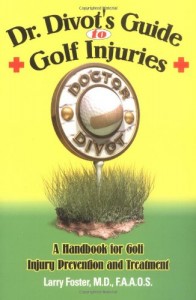Dr. Divot’s Guide to Golf Injuries: A Handbook for Golf Injury Prevention and Treatment
Dr. Larry Foster is an orthopedic surgeon, a self-described golf nut, and a man on a mission.
He believes that his fellow golfers could enjoy their game more if they had a basic understanding of how the human body handles (or sometimes doesn’t handle) the incredible stresses and strains put on the musculoskeletal frame during a round of golf.
For many folks, the idea that golf can produce debilitating injuries is pretty laughable. After all, walking a few miles and taking several dozen whacks at a small ball simply can’t be like football or rugby, where the chance for injury is obvious.
If these folks read Dr. Divot’s Guide, however, they would quickly correct their misimpression.
Foster’s research of the sports medicine literature shows that certain kinds of problems afflict most golfers, whether they are pros or occasional weekend duffers. In fact, several injuries are more commonly experienced by amateur golfers, thanks in large part to their comparative lack of talent.
In studies cited by Dr. Foster, the enhanced skills of the professional golfers produce a more efficient use of their muscles, which reduces the chance for harm from going all out.
Anyone watching a group of LPGA players on a practice range can easily see this, as I did several years ago during an LPGA Championship at Dupont Country Club. The women’s swings appear to be remarkably slower than many male amateurs.
On the other hand, the LPGA players hit the sweet spot far more often, and easily outdrive most men. During PGA Tour telecasts, one frequently hears the pros and commentators referring to using about ¾ effort on a given iron shot, with results far superior to what most amateurs can do.
For each common ailment, such as wrist injuries, Dr. Foster sketches out the basic anatomy of the bone and muscle groups involved. He details how the injuries are most likely to occur and the common treatments used by surgeons and other health care professionals in resolving the complaints. He then describes some of the practical techniques that could help some golfers avoid serious injury altogether.
Dr. Foster makes liberal use of several teaching techniques throughout this book.
First, there’s a very pleasant tone to his writing. His enthusiasm for his subject is obvious. While there’s no denying how serious some golf-related injuries can be, his attitude is one of “here’s how you and I can fix this.” From my perspective, his mannerisms help instill confidence in the approaches he suggests.
On the other hand, as a budding stand-up comedian I respectfully suggest Dr. Foster should stick to the operating room. There are some real groaners here.
Second, the dozens of illustrations appearing throughout the book help make the technical aspects of the discussion far more easily understandable for those of us with only a passing knowledge of medical matters. In addition, Dr. Foster provides handy citations to the medical research supporting his advice, included in the back of the book in a detailed reference guide.
Third, the book’s structure is well-suited to the subject. In this respect it is similar to the hugely popular Books for Dummies®, with their short passages, frequent bullet points, and helpful graphics.
Dr. Foster recommends reading the book all the way through, and then returning to the particular problem on which a reader might want to focus. At just over 210 pages, this won’t take long, especially since it’s also highly readable. I learned quite a bit about my own nagging problems with my left wrist, and the segment on chondromalacia dovetailed nicely with the advice I received a long time ago from a local orthopedic specialist.
This book has earned its place on the shelf next to Dr. Ed Palank’s Golf Doc and Dr. Bill Mallon’s Golf Doctor. It is a valuable addition to the helpful medical literature on golf.
Review Date: April 11, 2004


